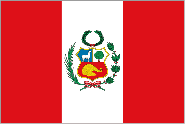Supporting Peru to advance their NAP process
Project Overview
Sep 2015
Peru submits their Intend Nationally Determined Contribution (INDC) to the Paris Agreement, which states their intention to develop a NAP by 2020
Apr 2016
Peru receives technical assistance by NAP-GSP and UNDP to advance the NAP process and develop a NAP roadmap
Jul 2016
Peru ratifies the Paris Agreement and submits their First NDC

Country background, Sustainable Development Goals and Paris Agreement
The Republic of Peru is located in the north-west of South America, with 2,414 kilometres of Pacific Ocean coastline. It has seven of the nine characteristics recognised to be “particularly vulnerable” to climate change impacts, by the UNFCCC. Studies reveal that temperatures and rainfall patterns are changing throughout the country. It is predicted that precipitation will decrease between 10 to 20 percent in the mountain regions and the northern and central Amazon areas, while the coastal regions are likely to experience an increase in rainfall of around 10 percent. The hydrological system is also being affected through the retreat of glaciers, meaning a decline in dry season discharge. In addition to this, annual climate-induced threats such as frost, drought and floods are increasing, severely affecting many parts of the country.
As of 2018, about 28.02 percent of the Peruvian population is employed in agriculture, fishing and mining. And since 1960, Peru’s rural population declined from 53 to 22.28 percent. In these areas and areas inhabited by indigenous people, this reliance on natural resources and increasingly vulnerable ecosystems is problematic. Threatening climate events such as the 1997-1998 “El Niño” significantly impacted Peru’s economy with losses equivalent to 4.5 percent of that year’s GDP. Further, studies indicate that changes in the country’s future climatic state are likely to lower its real GDP up to 23.4 percent by 2050.
To combat these threats, Peru has developed an institutional framework underpinned by a series of policy documents. Its three National Communications (2001; 2010; 2016) to the UNFCCC outline the expected climate-related impacts up to 2100, and details ongoing and planned interventions initiated by the government. These climate change documents, along with key national development plans such as the Bicentenary Plan or the National Strategy for Development and Social Inclusion aim to protect the significant development gains and economic strengthening Peru has experienced over the last decade, paving the way towards achieving the Sustainable Development Goals. Furthermore, Peru’s Nationally Determined Contribution (NDC) to the UNFCCC outlines specific areas of focus for climate change adaptation policies. The following systems and sectors are highlighted as priorities: water and water resources; agriculture; fisheries; forestry; and health. It is also important to note that 77.72 percent of Peru’s population lives in urban areas, and due to this fact, the NDC acknowledges how essential it is for Peru to promote the concept of "Resilient Cities" as units of climate risk management.
How has the NAP-GSP supported to date?
|
Helped to advance their NAP process |
In particular, by working closely with the Ministry of Environment to advise them on the development of the NAP roadmap. |
|
Conducted a support mission to Peru |
Between 18-22 April 2016, the NAP-GSP undertook a mission to Peru. The objectives of the mission were to: (1) work with the Ministry of Environment to review adaptation advances and develop a NAP roadmap; and (2) provide an overview of the UNFCCC guidelines for NAP, and shared experiences of other countries supported by NAP-GSP to a multi-stakeholder working group
|
News
29 April 2016, Lima, Peru - NAP-GSP and UNDP have provided technical assistance to Peru to advance their NAP process, by working closely with the Ministry of Environment to advise them on the development of the NAP roadmap. NAP-GSP has also provided an overview of the UNFCCC guidelines for NAP, and shared experiences of other countries supported by NAP-GSP to a multi-stakeholder working group during a support mission in April 2016.
> Highlights of support offered to advance Peru's NAP roadmap
